Oxidation Behavior of Pre-Strained Polycrystalline Ni3Al-Based Superalloy
Abstract
1. Introduction
2. Materials and Methods
2.1. Material and Specimen Preparation
2.2. Oxidation Test
2.3. Microstructure Characterization
3. Results
3.1. Microstructure of Original Alloy
3.2. Microstructure of Short-Term Oxidation Products
3.3. Oxidation Kinetics of Long-Term Cyclic Oxidation
4. Discussion
4.1. Oxidation Kinetics of Long-Term Cyclic Oxidation
4.2. Growth Behavior of Short-Term Oxidation Products
4.3. Growth Behavior of Long-Term Cyclic Oxidation Products
4.4. Growth Mechanism of Oxidation Products
5. Conclusions
Author Contributions
Funding
Institutional Review Board Statement
Informed Consent Statement
Data Availability Statement
Conflicts of Interest
References
- Theska, F.; Street, S.R.; Pick, M.L.; Primig, S. Grain boundary microstructure-property relationships in the cast & wrought Ni-based superalloy René 41 with boron and carbon additions. Acta Mater. 2023, 258, 119235. [Google Scholar]
- Li, W.Q.; Zhao, X.B.; Cheng, Y.; Yue, Q.Z.; Xia, W.S.; Gu, Y.F. Effect of molybdenum on cyclic oxidation behavior of 4th generation nickel-based single crystal superalloys. Corros. Sci. 2023, 223, 111458. [Google Scholar] [CrossRef]
- Sridar, S.; Pizano, L.F.L.; Klecka, M.A.; Xiong, W. Achieving High Strength and Creep Resistance in Inconel 740H Superalloy through Wire-Arc Additive Manufacturing and Thermodynamic-Guided Heat Treatment. Materials 2023, 16, 6388. [Google Scholar] [CrossRef] [PubMed]
- Pollock, T.M.; Tin, S. Nickel-based superalloys for advanced turbine engines: Chemistry, microstructure and properties. J. Propul. Power 2006, 22, 361–374. [Google Scholar] [CrossRef]
- Chang, C.; Jiang, L.W.; Wu, M.L.; Li, S.S.; Han, Y.F. Effect of temperature and stress on high temperature creep behavior of Ni3Al-based single crystal superalloy. Prog. Nat. Sci. Mater. Int. 2022, 32, 267–271. [Google Scholar] [CrossRef]
- David, S.A.; Deevi, S.C. Welding of unique and advanced ductile intermetallic alloys for high-temperature applications. Sci. Technol. Weld. Join. 2017, 22, 681. [Google Scholar] [CrossRef]
- Deevi, S.C.; Sikka, V.K. Nickel and iron aluminides: An overview on properties, processing, and applications. Intermetallics 1996, 4, 357–375. [Google Scholar] [CrossRef]
- Zhao, Y.H.; Li, Y.; Sun, Y.W.; Han, R.H.; Li, X.P.; Xie, Y.S.; Zheng, H.X.; Zhao, C.Z. Microstructure and mechanical properties of a novel polycrystalline Ni3Al-based intermetallic alloy. Intermetallics 2023, 158, 107908. [Google Scholar] [CrossRef]
- Wu, J.; Li, C.; Liu, Y.C.; Wu, Y.T.; Guo, J.Y.; Li, H.J.; Wang, H.P. Effect of annealing treatment on microstructure evolution and creep behavior of a multiphase Ni3Al-based superalloy. Mater. Sci. Eng. A 2019, 743, 623–635. [Google Scholar] [CrossRef]
- Guo, J.Y.; Li, Y.F.; Li, C.; Yu, L.M.; Li, H.J.; Wang, Z.M. Isothermal oxidation behavior of micro-regions in multiphase Ni3Al-based superalloys. Mater. Charact. 2021, 171, 110748. [Google Scholar] [CrossRef]
- Zhao, Y.H.; Chang, Y.P.; Li, X.P.; Xie, Y.S.; Sun, Y.S.; Zhang, H.X.; Zhao, C.Z. P phase precipitation and strengthening behavior of a novel polycrystalline Ni3Al-based intermetallic alloy at 1100 °C. Acta Mater. 2024, 265, 119601. [Google Scholar] [CrossRef]
- He, X.; Liu, C.; Yang, Y.K.; Ding, J.; Chen, X.G.; Xia, X.C.; Tang, Y.; Liu, Y.C. Directional coarsening behavior of primary γ′ phase in Ni3Al-based superalloy during aging heat treatment. J. Alloys Compd. 2021, 872, 159674. [Google Scholar] [CrossRef]
- Ding, J.; Jiang, S.; Wu, Y.T.; Li, Y.M.; Xia, X.C.; Li, C.; Liu, Y.C. Precipitation and growth behavior of mushroom-like Ni3Al. Mater. Lett. 2018, 211, 5–8. [Google Scholar] [CrossRef]
- Kobayashi, S.; Demura, M.; Kishida, K.; Hirano, T. Tensile and bending deformation of Ni3Al heavily cold-rolled foil. Intermetallics 2005, 13, 608–614. [Google Scholar] [CrossRef]
- Polkowski, W.; Jozwik, P.; Bojar, Z. Differential speed rolling of Ni3Al based intermetallic alloy-Analysis of the deformation process. Mater. Lett. 2015, 139, 46–49. [Google Scholar] [CrossRef]
- Wu, C.H.; Jiang, R.; Zhang, L.C.; Wang, Y.C.; Chen, Y.; Song, Y.D. Oxidation accelerated dwell fatigue crack growth mechanisms of a coarse grained PM Ni-based superalloy at elevated temperatures. Corros. Sci. 2022, 209, 110702. [Google Scholar] [CrossRef]
- Tan, L.; Ren, X.; Sridharan, K.; Allen, T.R. Effect of shot-peening on the oxidation of alloy 800H exposed to supercritical water and cyclic oxidation. Corros. Sci. 2008, 50, 2040–2046. [Google Scholar] [CrossRef]
- Kuenzly, J.D.; Douglass, D.L. The Oxidation mechanism of Ni3Al Containing Yttrium. Oxid. Met. 1974, 8, 140–177. [Google Scholar] [CrossRef]
- Liu, H.; Xu, M.M.; Li, S.; Bao, Z.B.; Zhu, S.L.; Wang, F.H. Improving cyclic oxidation resistance of Ni3Al-based single crystal superalloy with low-diffusion platinum-modified aluminide coating. J. Mater. Sci. Technol. 2020, 54, 132–143. [Google Scholar] [CrossRef]
- Xu, B.Q.; Jiang, J.S.; Zou, Z.H.; Wang, W.Z.; Zhao, X.F.; Liu, Y.Z.; Xiao, P. Time-dependent spalling behavior of thermally grown oxide induced by room temperature interfacial deformation. Surf. Coat. Technol. 2018, 334, 164–172. [Google Scholar] [CrossRef]
- Chen, H.; Fan, M.; Li, L.; Zhu, W.; Li, H.N.; Li, J.; Yin, Y. Effects of internal oxide contents on the oxidation and β-phase depletion behaviour in HOVF CoNiCrAlY coatings. Surf. Coat. Technol. 2021, 424, 127666. [Google Scholar] [CrossRef]
- Li, J.A.; Peng, Y.Y.; Zhang, J.B.; Jiang, S.; Yin, S.P.; Ding, J.; Wu, Y.T.; Wu, J.; Chen, X.G.; Xia, X.C.; et al. Cyclic oxidation behavior of Ni3Al-basedsuperalloy. Vacuum 2019, 169, 108938. [Google Scholar] [CrossRef]
- Li, Y.M.; Lv, H.S.; Li, Y.B.; Fan, N.W. Effect of Pre-Oxidation on High-Temperature Oxidation Behavior of Al-Si Coating on Nickel-Based Superalloy. Materials 2022, 15, 7440. [Google Scholar] [CrossRef] [PubMed]
- Ye, X.J.; Yang, B.B.; Lai, R.L.; Liu, J.T.; Yu, S.; Li, Y.P. Effect of Nb addition on the internal oxidation of novel Ni-base superalloy. Corros. Sci. 2022, 198, 110100. [Google Scholar] [CrossRef]
- Ma, S.Y.; Ding, Q.Q.; Wei, X.; Zhang, Z.; Bei, H.B. The Effects of Alloying Elements Cr, Al, and Si on Oxidation Behaviors of Ni-Based Superalloys. Materials 2022, 15, 7352. [Google Scholar] [CrossRef] [PubMed]
- Zhou, Z.J.; Zhang, R.; Cui, C.Y.; Zhou, Y.Z.; Sun, X.F.; Qu, J.L.; Gu, Y.; Du, J.H.; Tan, Y. Deformation micro-twinning arising at high temperatures in a Ni-Co-based superalloy. J. Mater. Sci. Technol. 2022, 115, 10–18. [Google Scholar] [CrossRef]
- Garg, M.; Grewal, H.S.; Sharma, R.K.; Gwalani, B.; Arora, H.S. Limiting oxidation of high entropy alloy via high strain-rate deformation: Insights from electrochemical impedance spectroscopy. Mater. Chem. Phys. 2023, 294, 127017. [Google Scholar] [CrossRef]
- Garg, M.; Grewal, H.S.; Sharma, R.K.; Gwalani, B.; Arora, H.S. High oxidation resistance of AlCoCrFeNi high entropy alloy through severe shear deformation processing. J. Alloys Compd. 2022, 917, 165385. [Google Scholar] [CrossRef]
- Lee, C.M.; Han, Y.S.; Jeong, J.S.; Jung, W.S.; Song, S.H.; Kim, J.S. Effect of pre-strain on oxidation behaviour of nickel-based superalloys in air at 700 °C. Corros. Sci. 2022, 200, 110229. [Google Scholar] [CrossRef]
- Zhou, C.H.; Ma, H.T.; Wang, L. Comparative study of oxidation kinetics for pure nickel oxidized under tensile and compressive stress. Corros. Sci. 2010, 52, 210–215. [Google Scholar] [CrossRef]
- Zhou, C.H.; Pan, R.Y.; Ma, H.T.; Zhang, H.; Guan, X.G.; Mao, N.N.; Sun, F.J. Oxidation Kinetics Researches under the Condition of Compressive Loading. IOP Conf. Ser. Mate. Sci. Eng. 2018, 389, 012017. [Google Scholar] [CrossRef]
- Wang, Y.; Zhang, M.; Jin, J.S.; Gong, P.; Wang, X.Y. Oxidation behavior of CoCrFeMnNi high entropy alloy after plastic deformation. Corros. Sci. 2020, 163, 108285. [Google Scholar] [CrossRef]
- Qi, H.Y.; Liang, X.B.; Li, S.L.; Yang, X.G. High-temperature oxidation behavior of DZ125 Ni-based superalloy under tensile stress. Rare Met. 2016, 41, 4188–4193. [Google Scholar] [CrossRef]
- Barnard, B.R.; Liaw, P.K.; Buchanan, R.A.; Klarstrom, D.L. Affects of applied stresses on the isothermal and cyclic high-temperature oxidation behavior of superalloys. Mater. Sci. Eng. A 2010, 527, 3813–3821. [Google Scholar] [CrossRef]
- GB/T 7314-2017. Metallic Materials-Compression Test Method at Room Temperature. Standardization Administration of the People’s Republic of China: Beijing, China.
- Zou, Y.; Li, S.L.; Liu, S.H.; Li, J.K.; Li, Y. Improved mechanical and corrosion properties of CrMnFeCoNi high entropy alloy with cold rolling and post deformation annealing process. J. Alloys Compd. 2021, 887, 161416. [Google Scholar] [CrossRef]
- Ding, Q.Q.; Shen, Z.J.; Xiang, S.S.; Tian, H.; Li, J.X.; Zhang, Z. In-situ environmental TEM study of γ′-γ phase transformation induced by oxidation in a nickel-based single crystal superalloy. J. Alloys Compd. 2015, 651, 255–258. [Google Scholar] [CrossRef]
- Sakaguchi, M.; Ike, M.; Okazaki, M. Microstructural changes in a single crystal Ni-base superalloy induced by plastic straining. Mater. Sci. Eng. A 2012, 534, 253–259. [Google Scholar] [CrossRef]
- Li, S.C.; Liang, H.Y.; Li, C.; Liu, Y.C. Lattice mismatch in Ni3Al-based alloy for efficient oxygen evolution. J. Mater. Sci. Technol. 2022, 106, 19–27. [Google Scholar] [CrossRef]
- Kim, J.H.; Hwang, I.S. evelopment of an in situ Raman spectroscopic system for surface oxide films on metals and alloys in high temperature water. Nucl. Eng. Des. 2005, 235, 1029–1040. [Google Scholar] [CrossRef]
- Maslar, J.E.; Hurst, W.S.; Bowers, W.J.; Hendrick, J.H.; Aquino, M.I. In Situ Raman Spectroscopic Investigation of Nickel Hydrothermal Corrosion. Corros. Sci. 2001, 58, 225–231. [Google Scholar] [CrossRef]
- Ashkin, M.; Parker, J.H.; Feldam, D.W. Temperature dependence of the Raman lines of α-Al2O3. Solid State Commun. 1968, 6, 343–346. [Google Scholar] [CrossRef]
- Aminzadeh, A. Excitation Frequency Dependence and Fluorescence in the Raman Spectra of Al2O3. Appl. Spectrosc. 1997, 54, 817–819. [Google Scholar] [CrossRef]
- ElBatal, F.H.; Morsi, R.M.; Ouis, M.A.; Marzouk, S.Y. UV–visible, Raman and E.S.R. studies of gamma-irradiated NiO-doped sodium metaphosphate glasses. Spectrochimca Acta Part A 2010, 77, 717–726. [Google Scholar] [CrossRef] [PubMed]
- Li, C.; Song, P.; Khan, A.; Feng, J.; Chen, K.L.; Zang, J.J.; Xiong, X.P.; Lu, J.G.; Lu, J.S. Influence of water vapour on the HfO2 distribution within the oxide layer on CoNiCrAlHf alloys. J. Alloys Compd. 2018, 739, 690–699. [Google Scholar] [CrossRef]
- Shao, Y.Y.; Yuan, J.H.; Li, X.N.; Li, Z.M.; Hu, Y.L.; Cheng, Z.L.; Liu, R.W.; Zhang, R.; Zheng, R.; Hou, Y.D.; et al. Compositional dependence of high temperature oxidation resistance in the L12-strengthened high-thermostability copper alloys. Corros. Sci. 2023, 220, 111281. [Google Scholar] [CrossRef]
- Liu, L.; He, J.; Zhou, B.Y.; Fan, D.Y.; Guo, H.B. The importance of grain boundaries on the reactive elements effect in β-NiAlHf alloy. Mater. Lett. 2023, 342, 134305. [Google Scholar] [CrossRef]
- Xiao, J.H.; Xiong, Y.; Wang, L.; Jiang, X.W.; Wang, D.; Li, K.W.; Dong, J.S.; Lou, L.H. Oxidation behavior of high Hf nickel-based superalloy in air at 900, 1000 and 1100 °C. Int. J. Miner. Metall. Mater. 2021, 28, 1957–1965. [Google Scholar] [CrossRef]
- Cao, X.Z.; He, J.; Chen, H.; Zhou, B.Y.; Liu, L.; Guo, H.B. The formation mechanisms of HfO2 located in different positions of oxide scales on ni-al alloys. Corros. Sci. 2020, 167, 108481. [Google Scholar] [CrossRef]
- Chu, C.H.; Guo, Q.Y.; Guan, Y.; Qiao, Z.X.; Liu, Y.C. Deformation mechanisms of a γʹ phase strengthened CoNi-based superalloy at high temperatures. Mater. Sci. Eng. A 2022, 833, 142587. [Google Scholar] [CrossRef]
- Chen, H.; Couvant, T.; Seyeux, A.; Duhamel, C.; Marcus, P. The effect of elastic and plastic strain on surface and intergranular oxidation of alloy 600 in simulated PWR primary water. Corros. Sci. 2023, 221, 111346. [Google Scholar] [CrossRef]
- Wood, G.C.; Chattopadhyay, B. Transient oxidation of Ni-based alloys. Corros. Sci. 1970, 10, 471–476. [Google Scholar] [CrossRef]

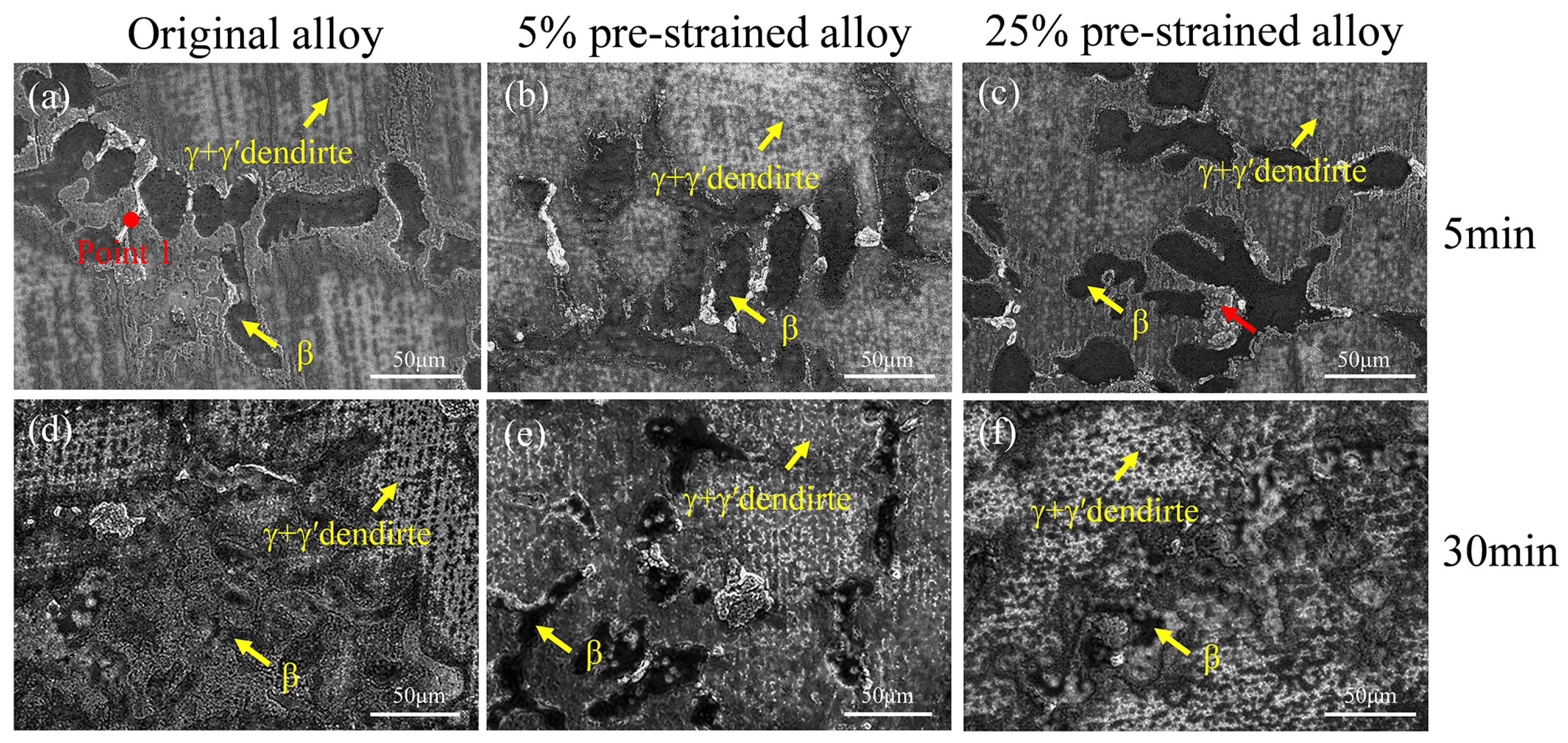
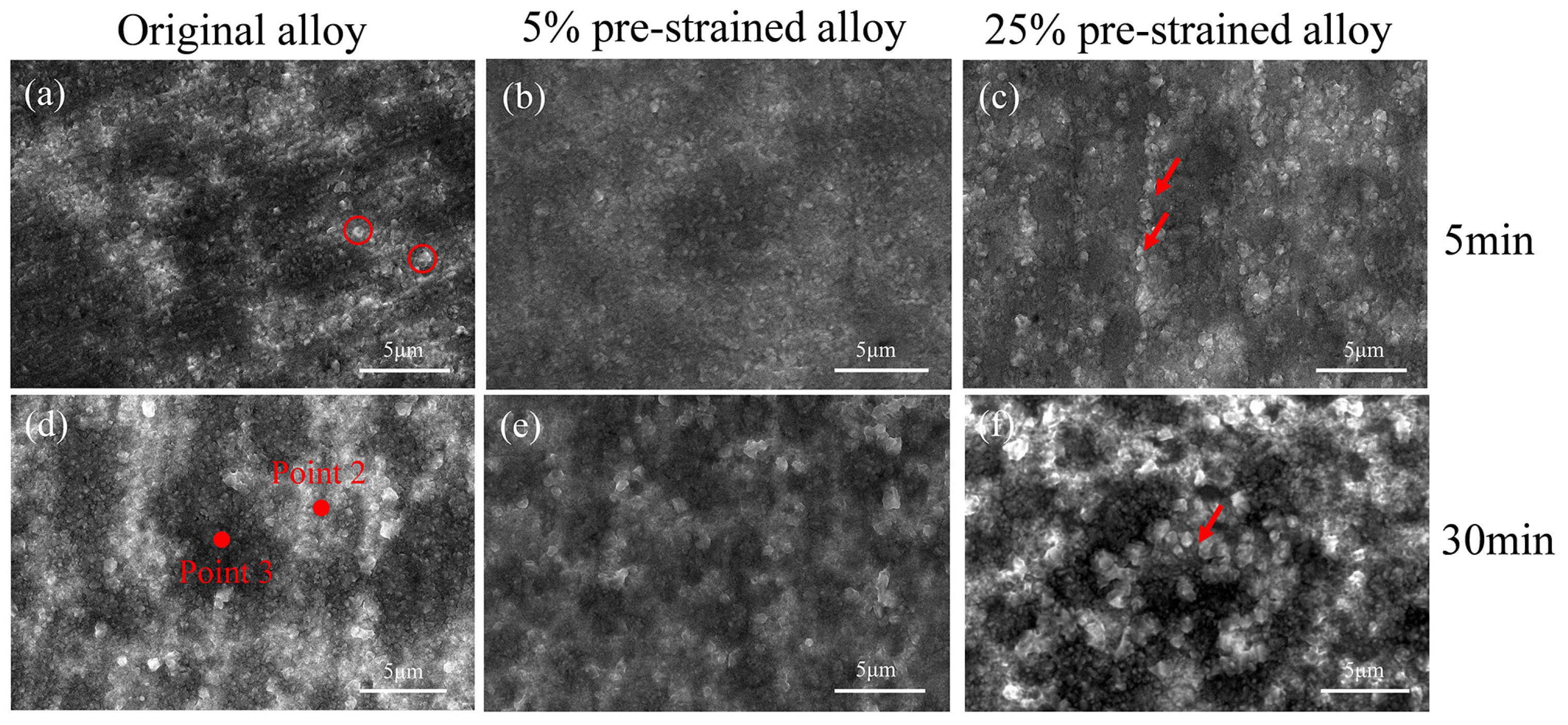
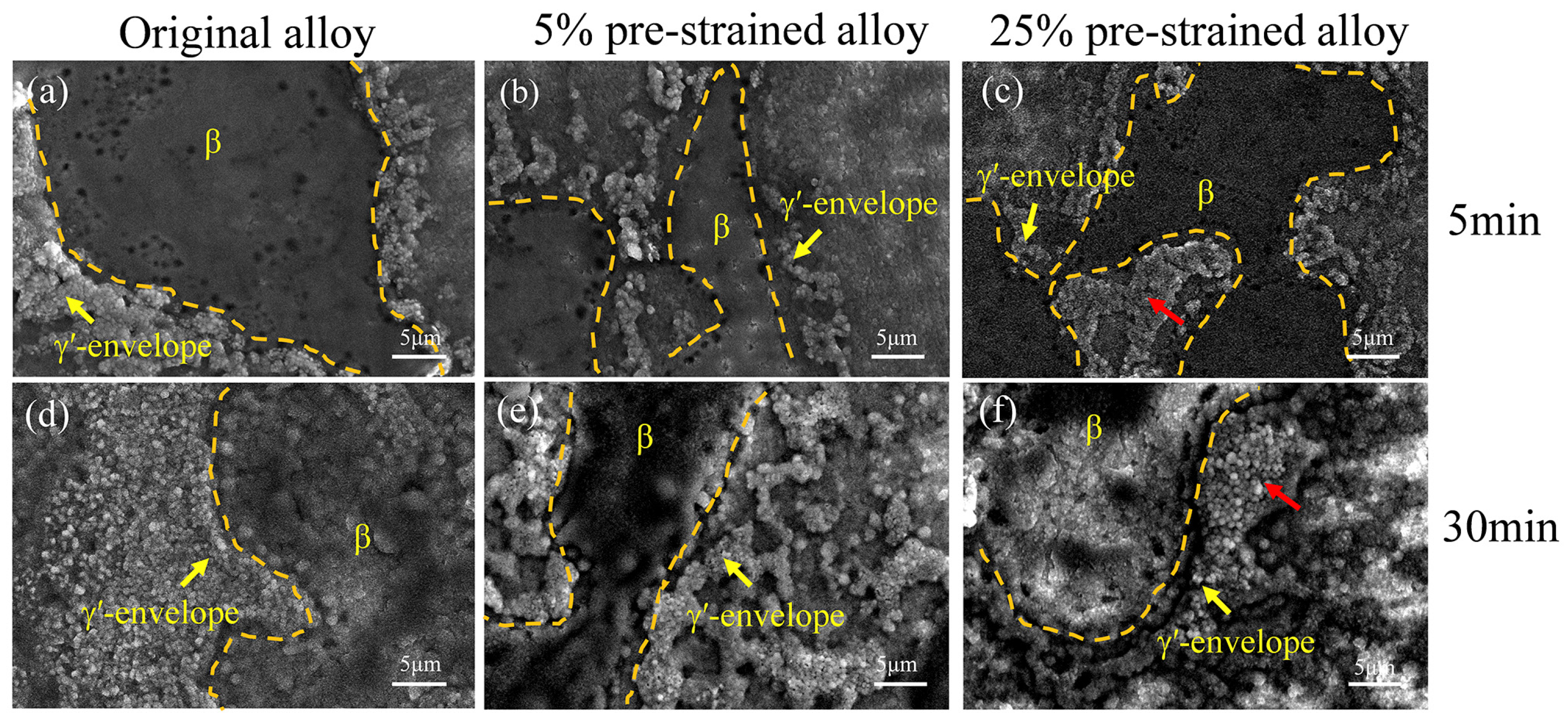
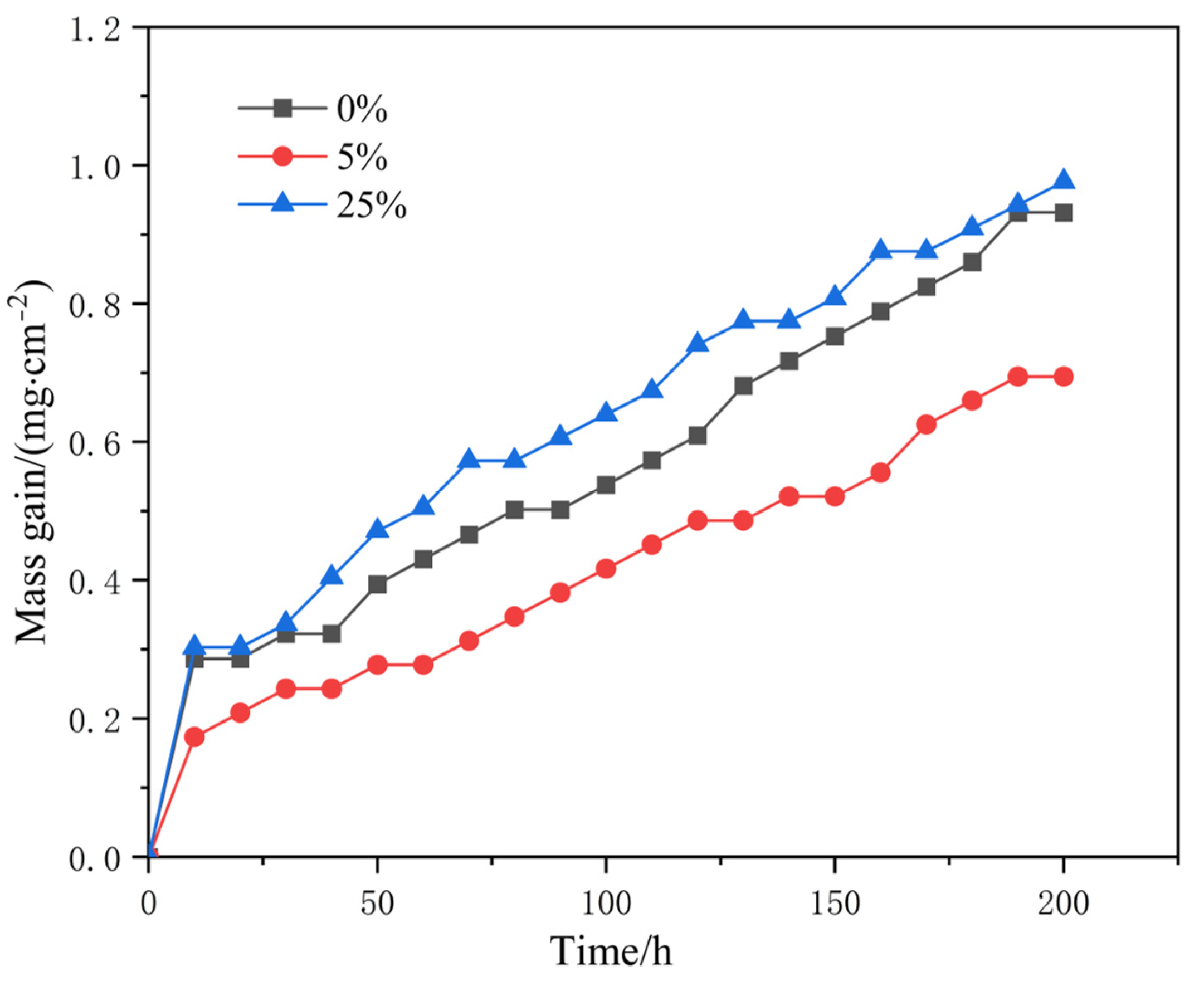
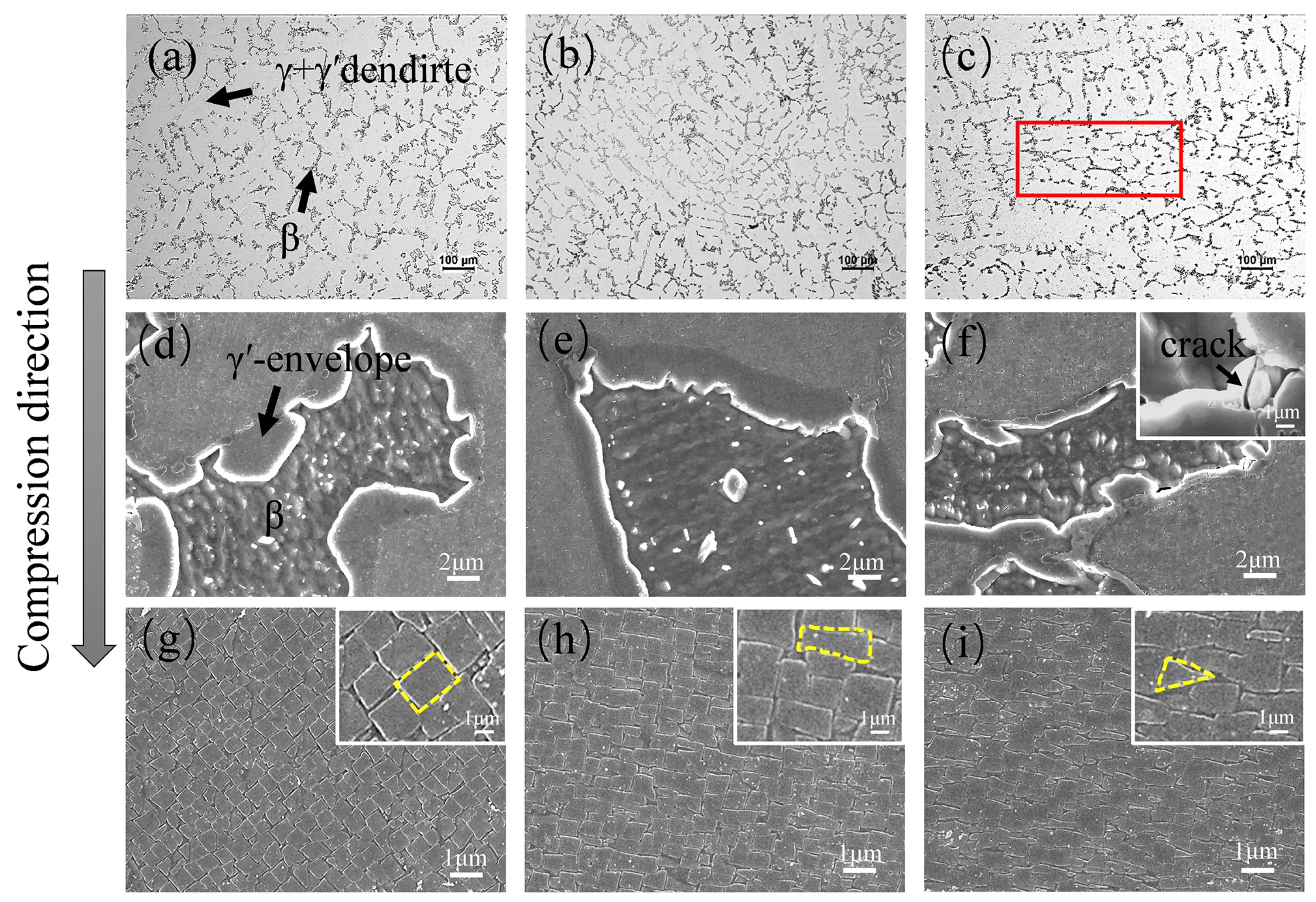
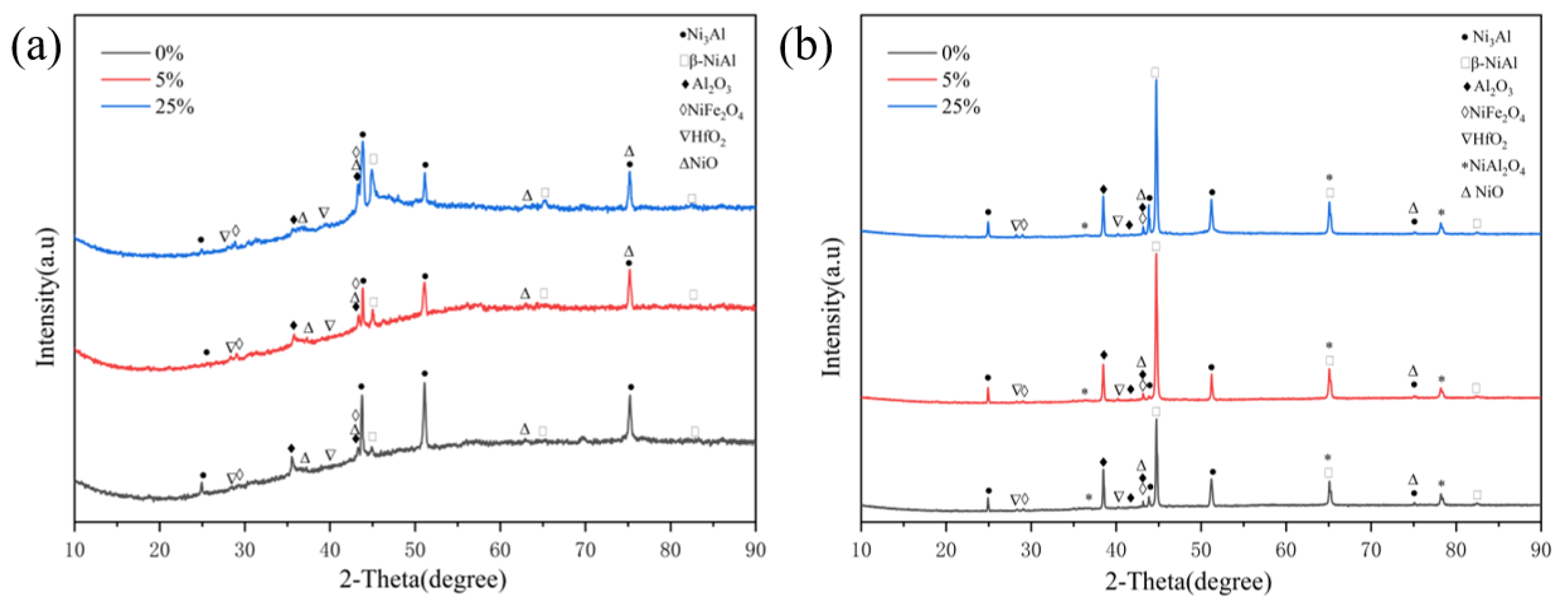
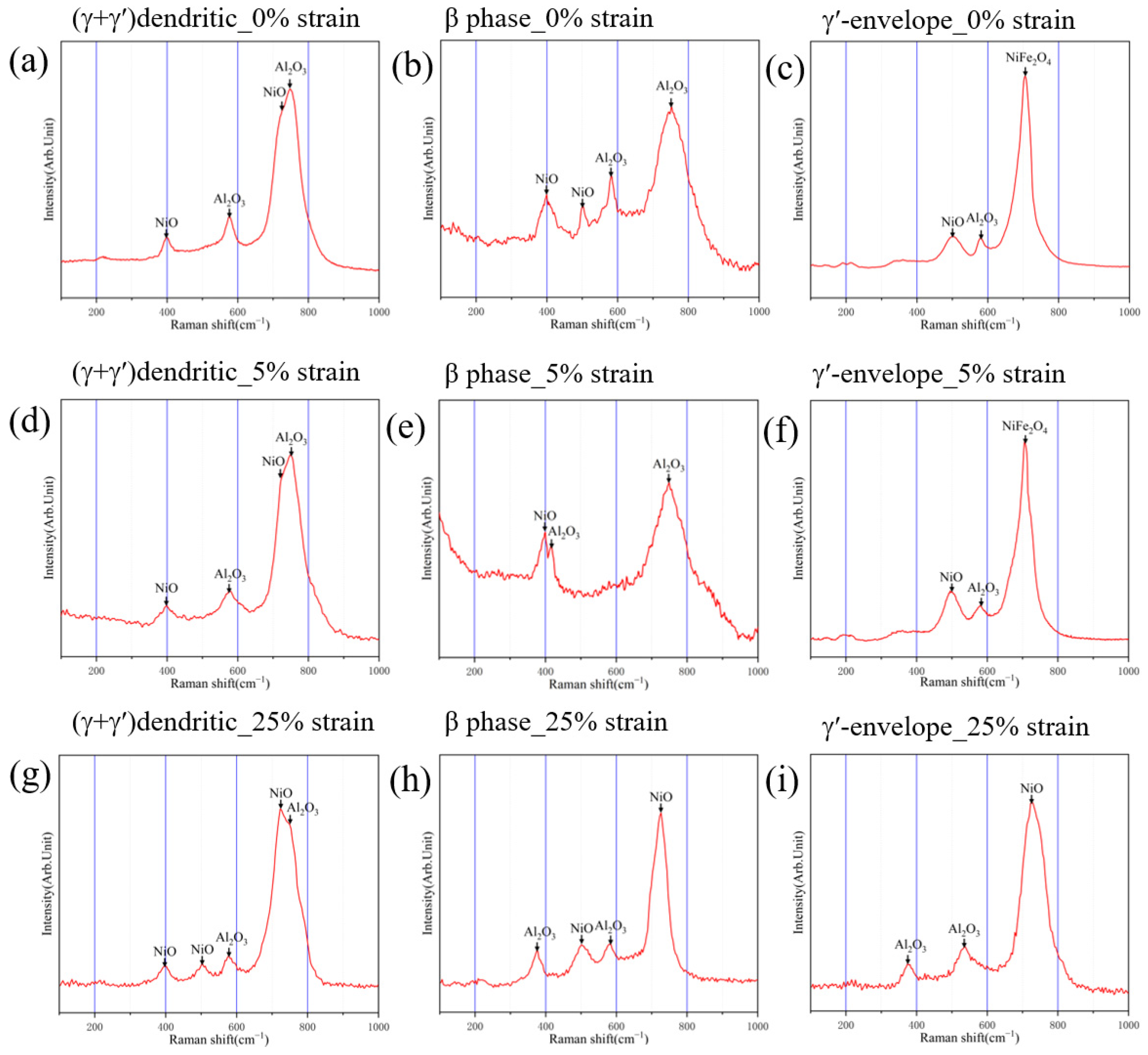
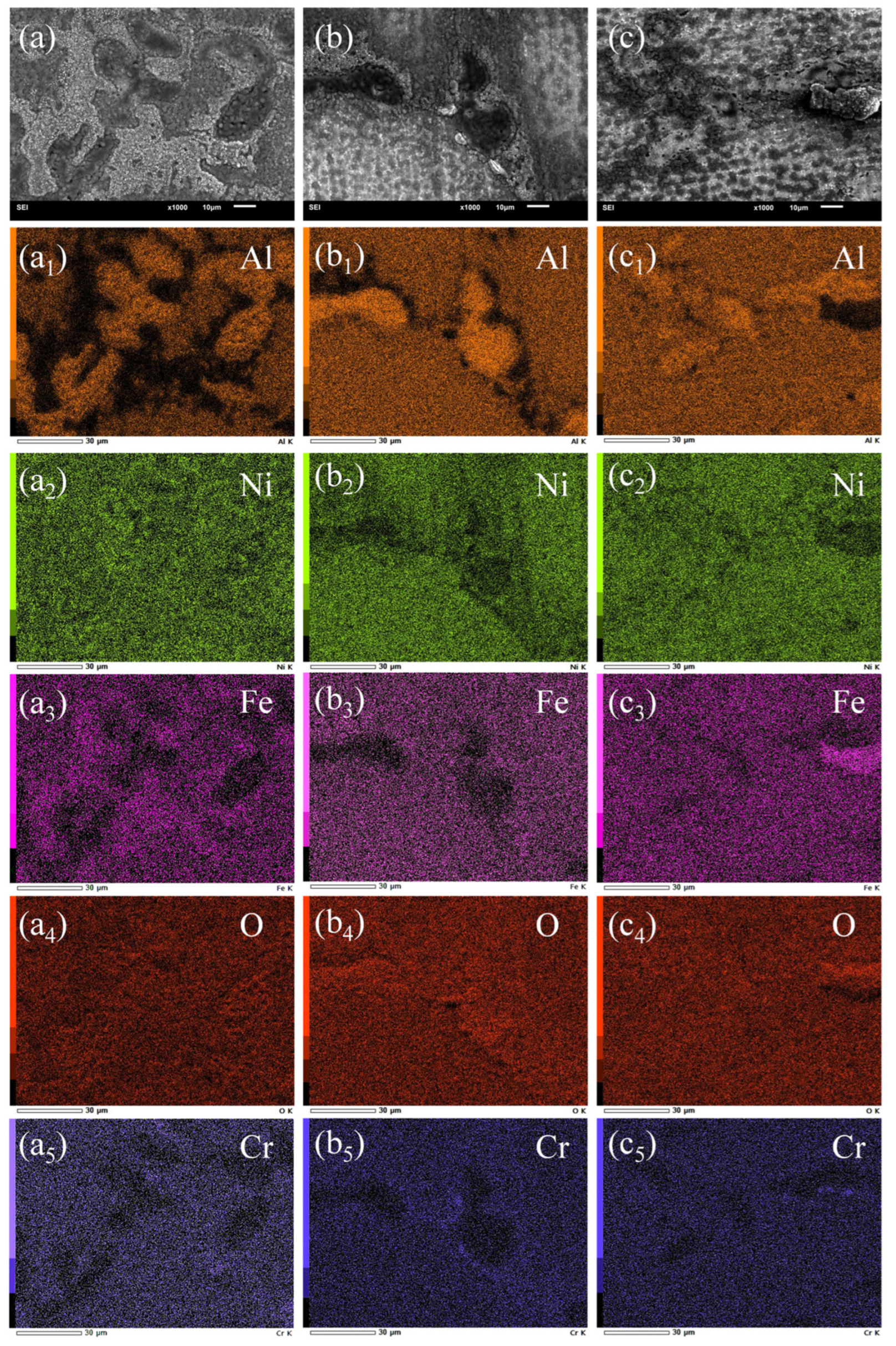
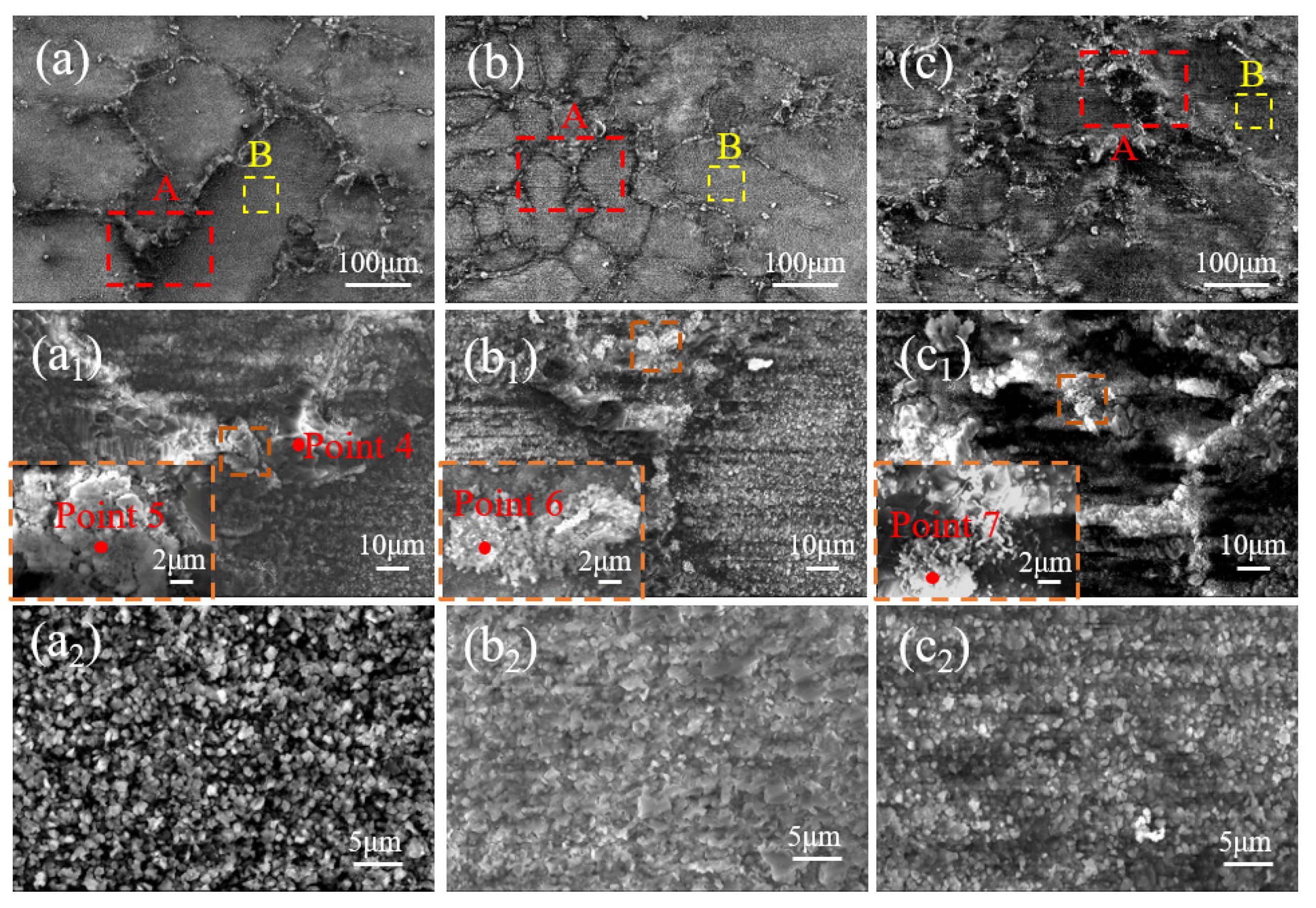
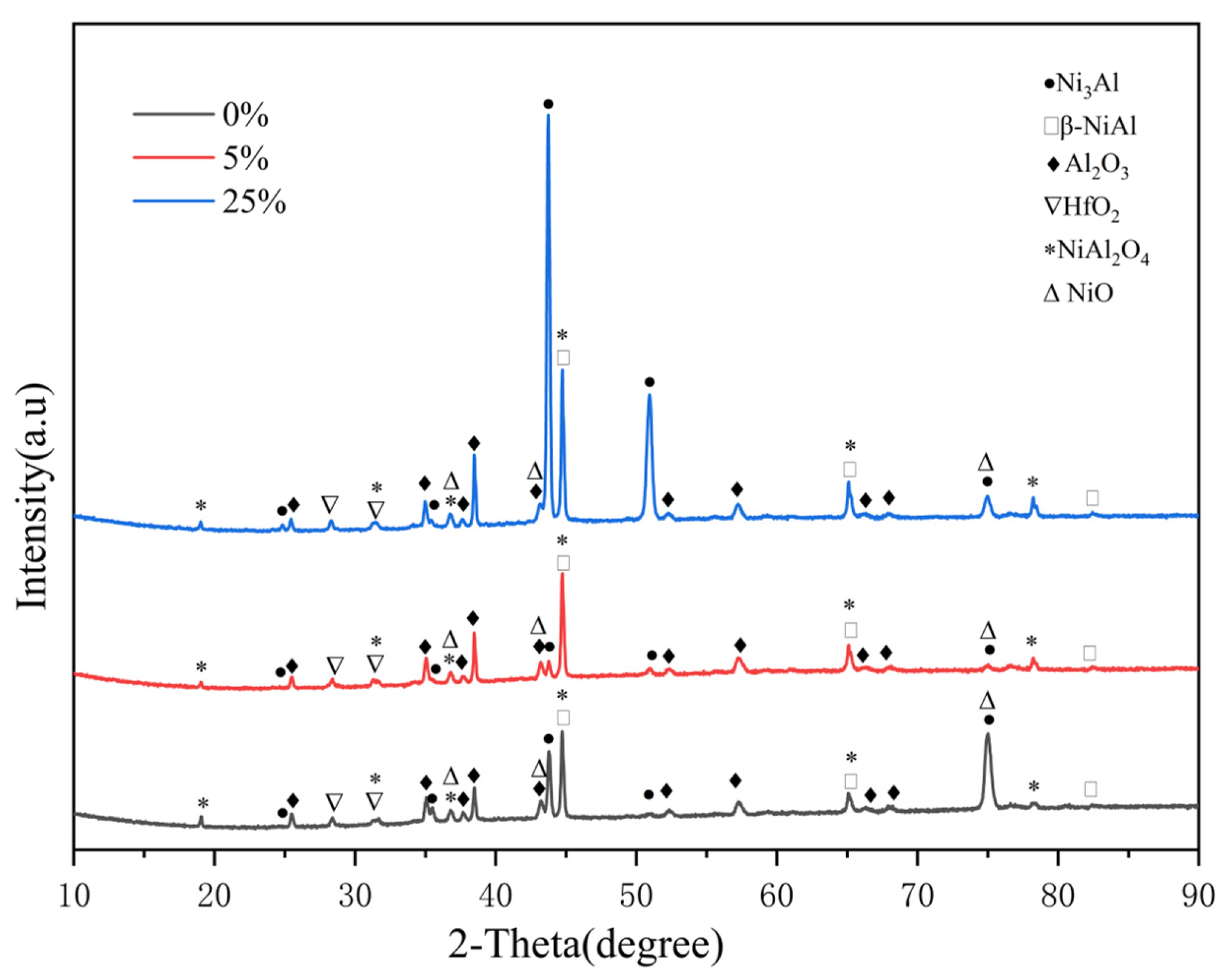
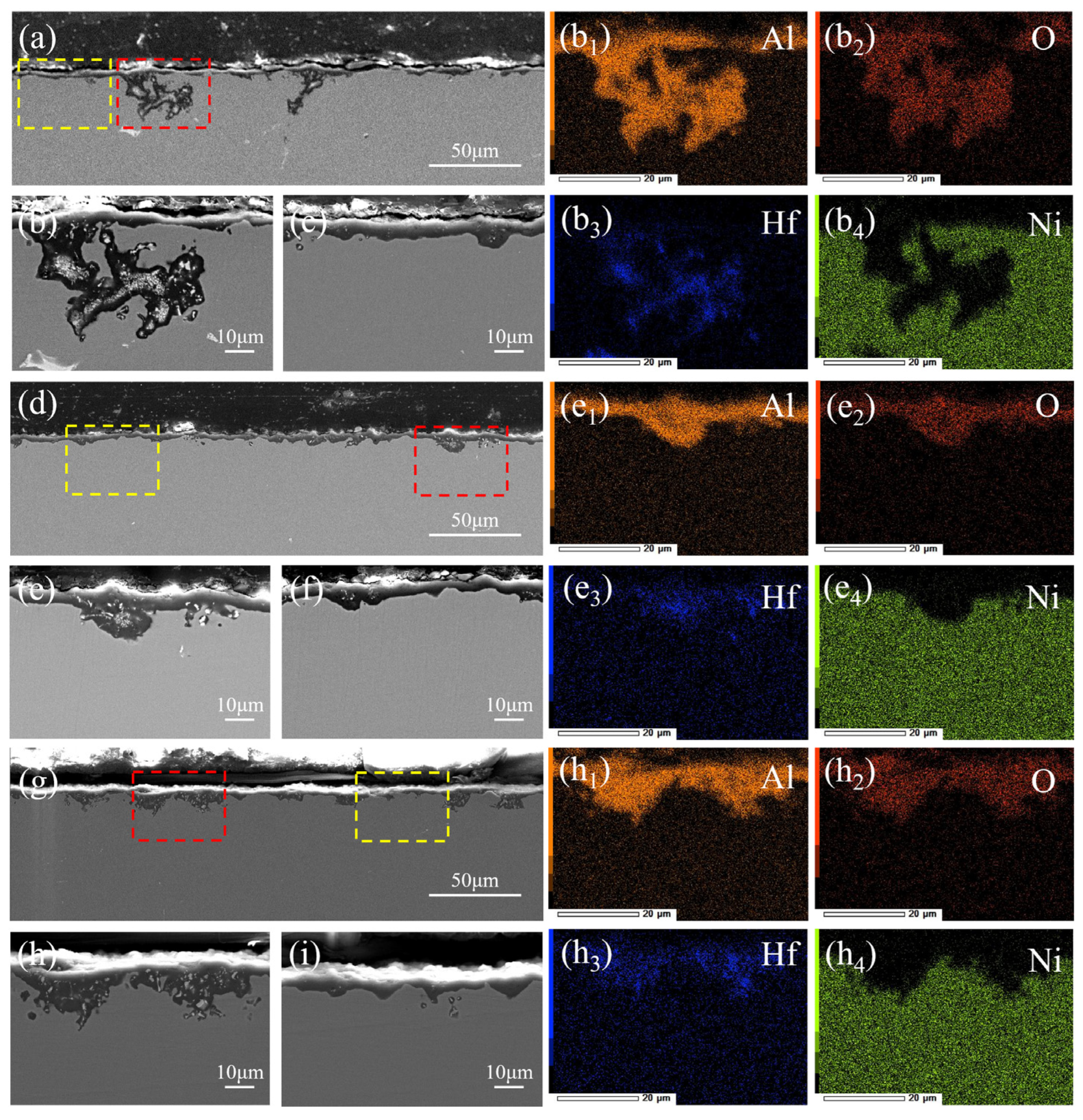
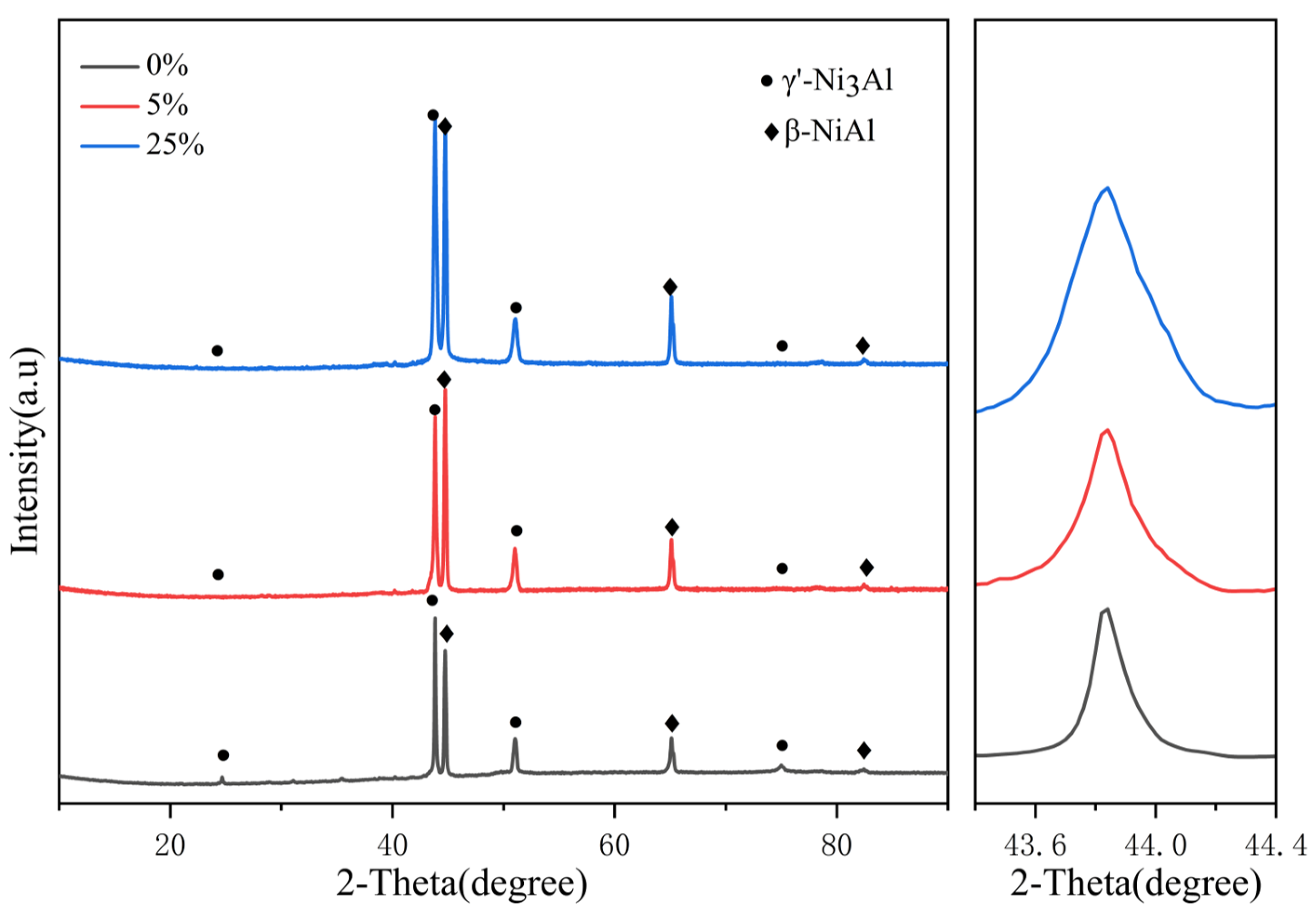
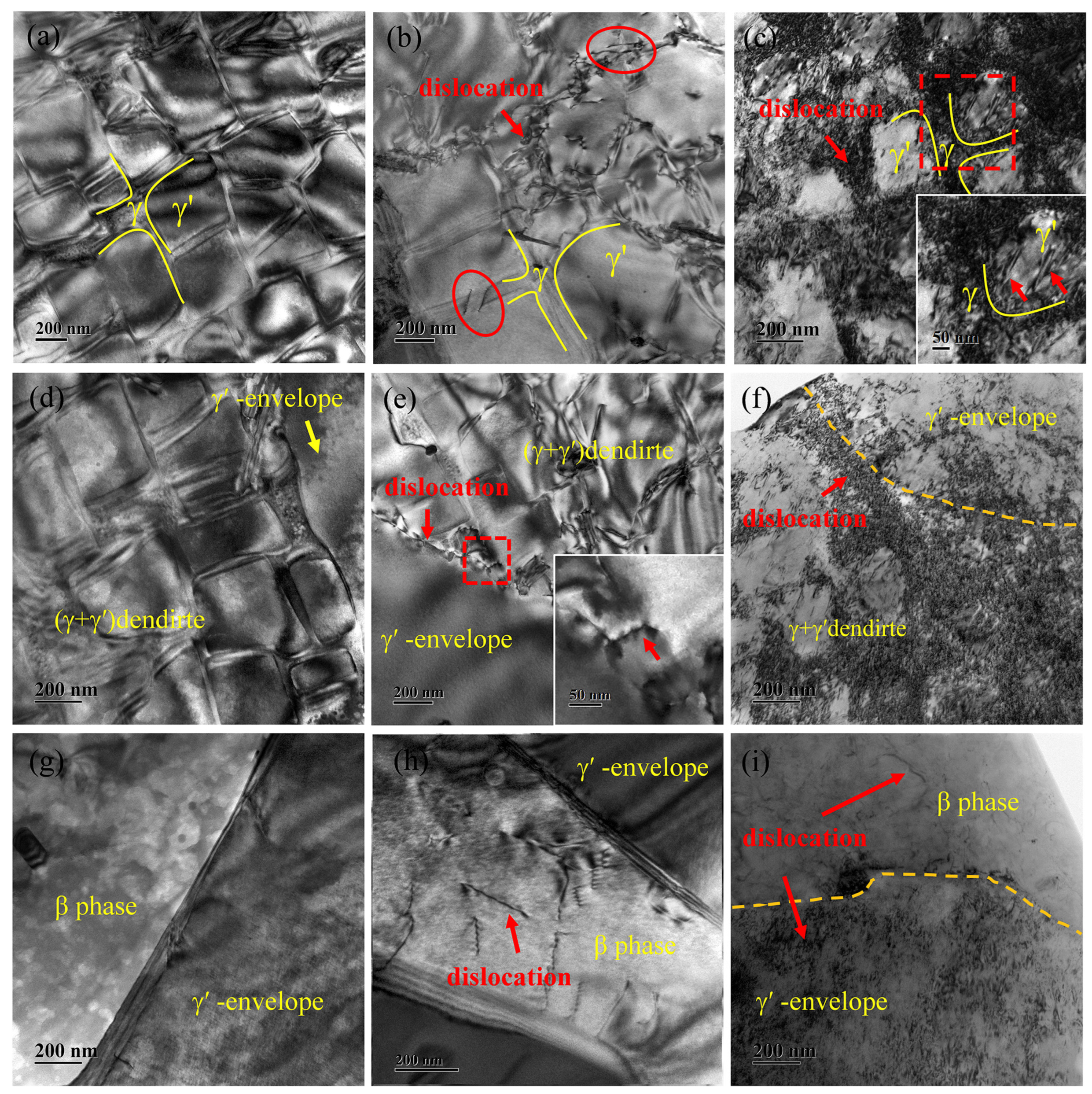
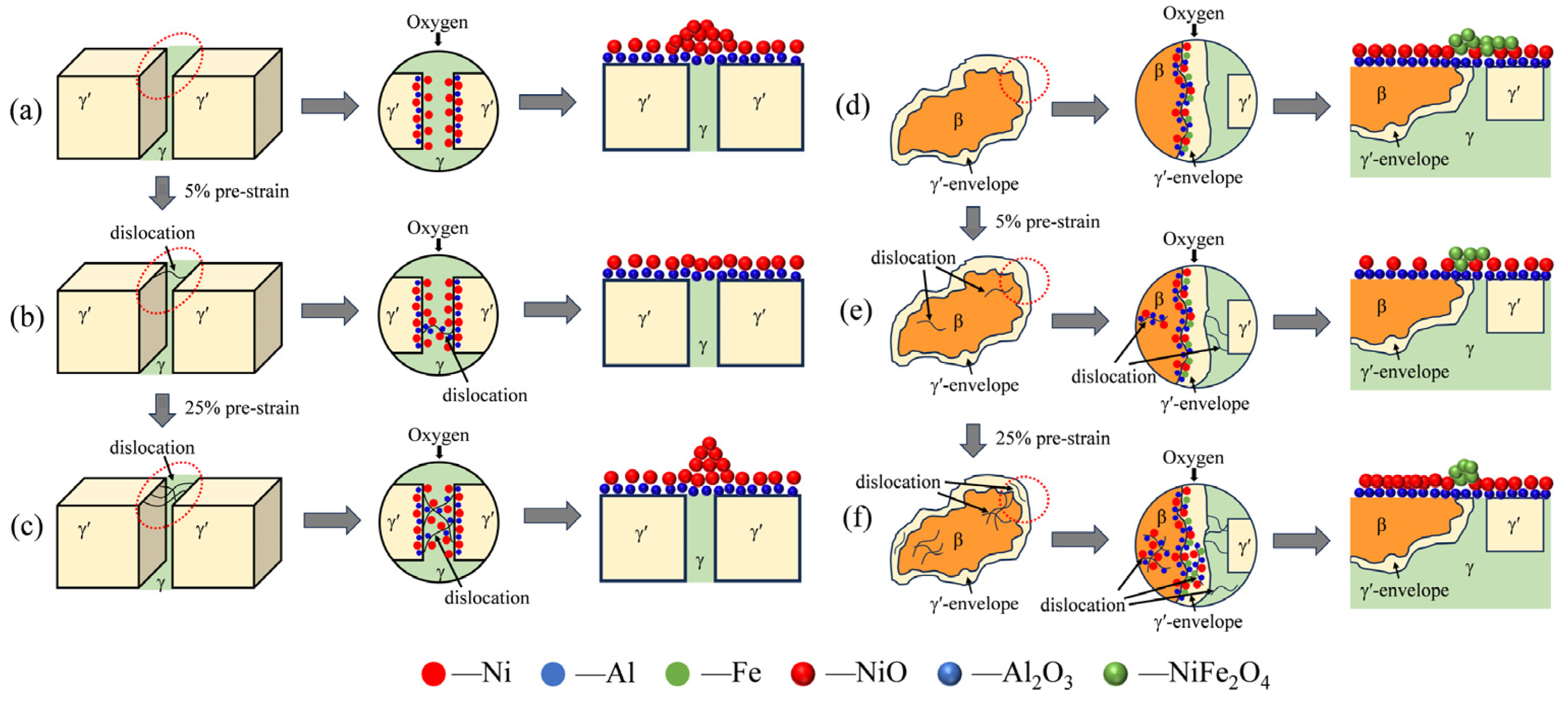
| C | Cr | Al | Ti | Hf | W | Mo | B | Fe | Si | Mn | Ni |
|---|---|---|---|---|---|---|---|---|---|---|---|
| 0.06–0.2 | 7.4–8.2 | 7.6–8.5 | 0.6–1.2 | 0.3–0.9 | 1.5–2.5 | 3.5–5.5 | <0.05 | <2 | <0.5 | <0.5 | Bal. |
| Site | Composition from EDS (at. %) | |||||
|---|---|---|---|---|---|---|
| Al | Cr | Fe | Ni | O | Hf | |
| 1 | 3.90 | 4.89 | 4.04 | 14.56 | 55.95 | 16.66 |
| 2 | 15.17 | 3.10 | 4.79 | 28.01 | 48.93 | 0.01 |
| 3 | 26.26 | 3.39 | 5.05 | 15.04 | 50.25 | 0.01 |
| 4 | 28.38 | 0.5 | 0.54 | 1.39 | 69.17 | 0.02 |
| 5 | 26.71 | 0.31 | 0.39 | 4.74 | 64.23 | 3.62 |
| 6 | 24.71 | 0.29 | 1.59 | 3.73 | 64.94 | 4.73 |
| 7 | 24.94 | 0.23 | 1.36 | 3.00 | 66.43 | 4.04 |
Disclaimer/Publisher’s Note: The statements, opinions and data contained in all publications are solely those of the individual author(s) and contributor(s) and not of MDPI and/or the editor(s). MDPI and/or the editor(s) disclaim responsibility for any injury to people or property resulting from any ideas, methods, instructions or products referred to in the content. |
© 2024 by the authors. Licensee MDPI, Basel, Switzerland. This article is an open access article distributed under the terms and conditions of the Creative Commons Attribution (CC BY) license (https://creativecommons.org/licenses/by/4.0/).
Share and Cite
Guo, R.; Ding, J.; Wang, Y.; Feng, H.; Chen, L.; Yang, J.; Xia, X.; Zhao, Y.; Li, J.; Ji, S.; et al. Oxidation Behavior of Pre-Strained Polycrystalline Ni3Al-Based Superalloy. Materials 2024, 17, 1561. https://doi.org/10.3390/ma17071561
Guo R, Ding J, Wang Y, Feng H, Chen L, Yang J, Xia X, Zhao Y, Li J, Ji S, et al. Oxidation Behavior of Pre-Strained Polycrystalline Ni3Al-Based Superalloy. Materials. 2024; 17(7):1561. https://doi.org/10.3390/ma17071561
Chicago/Turabian StyleGuo, Rui, Jian Ding, Yujiang Wang, Haomin Feng, Linjun Chen, Jie Yang, Xingchuan Xia, Yingli Zhao, Jun Li, Shuang Ji, and et al. 2024. "Oxidation Behavior of Pre-Strained Polycrystalline Ni3Al-Based Superalloy" Materials 17, no. 7: 1561. https://doi.org/10.3390/ma17071561
APA StyleGuo, R., Ding, J., Wang, Y., Feng, H., Chen, L., Yang, J., Xia, X., Zhao, Y., Li, J., Ji, S., & Luo, J. (2024). Oxidation Behavior of Pre-Strained Polycrystalline Ni3Al-Based Superalloy. Materials, 17(7), 1561. https://doi.org/10.3390/ma17071561





